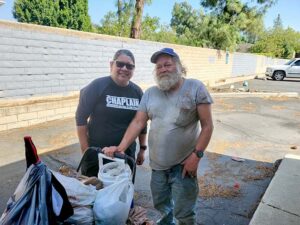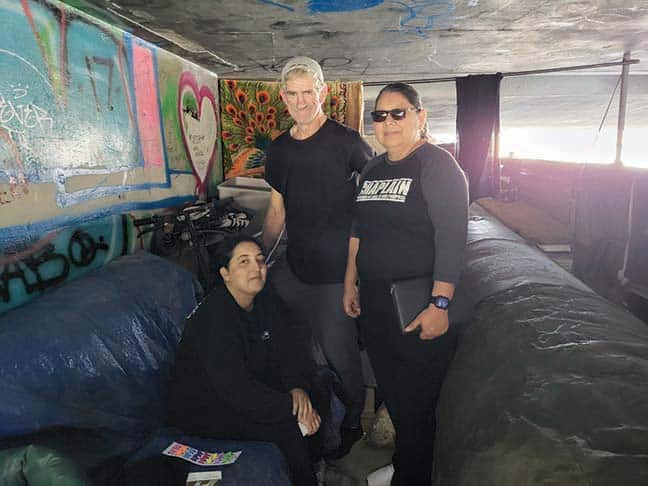Changing lives, odds be damned, Part II of III: ‘the warzone’

Chaplain Dianna Delgado is seen here on October 19 ministering to an unhoused man near the Montclair Target store at 9052 Central Ave. Delgado is part of Gabriel Fondario and Robert Hargett’s Homeless Outreach and Enforcement Unit’s team of collaborators working for better outcomes for Montclair’s unhoused population. Photo/courtesy of Gabriel Fondario
by Mick Rhodes | editor@claremont-courier.com
Part II of III: ‘the warzone’
In the mid-1980s Montclair was the murder capital of the Inland Empire. So brutal were the neighborhoods just above Holt Boulevard, along Bandera and Canoga streets and Kimberly Avenue, local NBC affiliate Channel 4 News dubbed them “the warzone.”
Fed up, the City of Montclair tasked its code enforcement officers to begin working closely with police and apartment owners to eliminate problem tenants. The hope was to improve safety and overall quality of life for the law-abiding residents there.
But like all cultural shifts, it would take time; even those being victimized were fearful, even distrustful.
The city had to find fresh ways to help mend these relationships. It found outside resources to offset food and clothing costs for hungry families; streamlined the process of obtaining mental and physical health referrals; and sourced tutors for struggling school-aged kids, among other efforts.
And over time, the new approach showed results.
“You’d see property appearance [improvements], you’d see cooperation from these people increase, morale, everything, because all the pieces of the puzzle were coming together and the burden would be lifted off their shoulders in other ways,” said Gabriel Fondario, who, along with Robert Hargett, makes up Montclair’s Homeless Outreach and Enforcement Unit. “We’ve always been allowed to get involved in things and go the extra mile to attack the problem neighborhoods [with] out-of-the- box thinking. Things like that were encouraged, and still are to this day.”
Montclair — like so many municipalities throughout California — has seen its unhoused population swell in recent years. A panoply of factors, including skyrocketing rents and medical costs, decades of cuts in public funding for mental health services, and a troubling surge in methamphetamine addiction, have all contributed.

Chaplain Dianna Delgado with chronic unhoused man Todd Williams on October 19 in Montclair. Gabriel Fondario and Robert Hargett, through the city’s Homeless Outreach and Enforcement Unit, have enrolled Williams in numerous alcohol rehab programs and paid his move-in costs at two shared housing units, but to no avail. As of today, he remains unhoused. Photo/courtesy of Gabriel Fondario
In March 2016, Montclair City Manager Edward Starr approached Fondario and Hargett with a proposal, to turn their focus to the city’s unhoused population as its Homeless Outreach Services Team.
It was a good call.
Code enforcement laws vary from city to city. Montclair, Fondario said, has always been on the vanguard of empowering its code enforcement officers to do more than ticket and arrest the unhoused.
“We sat on the [San Bernardino County] Housing Improvement Task Force, and we really got into the root causes of what causes neighborhood deterioration,” Fondario said. “We’ve had some pretty nasty neighborhoods here in our city.”
The pair, altruistic both by nature and circumstances — more on that in Part III — were buoyed by the code enforcement wins they were getting at work.
But a nagging question remained: how could they apply their newfound skills to the city’s burgeoning unhoused population? Enforcement was just one tool.
“You’ll never arrest your way out this homeless problem, ever,” Fondario said. It takes both enforcement and readily available resources, “as incentive for them to straighten out their lives. We realized it was going to be a challenge, because at the time I think we had about 85 to 90 homeless individuals in our city. You’d see open air drug dens. You’d see tents set up in groups at certain properties, 10 to 15 tents set up on lawns in different areas of our commercial locations.”

A pan of what appears to be canned chili cooks on a makeshift campfire on October 19 at an unhoused encampment of about 15 people adjacent to the San Antonio Flood Control Channel north of Mission Boulevard in Montclair. Photo/courtesy of Gabriel Fondario
Both remember their first call. It was with a man named Darryl Jetton at a Jack in the Box location on Central Avenue. Jetton was living between two nearby businesses.
“Of course, our first approach was to try to get him off the streets,” Fondario said. “And my gosh, he was very reluctant to accept any services, which unfortunately, he still is today. Darryl had been using for years prior to us making contact with him. And this is all stuff that we were learning on that first visit with him. We were trying to get a feel of … what happened to him? How did he end up at his age living on the street?”
It would turn out to be a precedent setting call.
They got to know Jetton over repeated interactions, searching again and again for a shelter or treatment center that would be a good fit for him, but more importantly, an option he’d accept. They learned he had at one point been living an average life with a job, a home, and a family.
Then came methamphetamine.
“We dug into his family and found out that he had a daughter and grandkids,” Fondario said. “We began even tapping into those resources to see if it would trigger something that would make him change his life.”
It was a shock, Fondario said, that Jetton — though he had family willing to take him in and support him in his rehabilitation — chose so nonchalantly to remain on the streets.
“And it also was an eye-opener into just how bad addiction can keep you in a bad spot and override everything, including your love for your family,” he said. “It kind of just takes full control. Nothing else is as important.”
Fondario and Hargett worked methodically to build a rapport with Montclair’s chronically unhoused community. They learned what worked and what did not. And just like with their earlier work in code enforcement, over the years they partnered with outside resources — pastors, advocates for the unhoused, homeless shelters, churches, and addiction recovery centers — to create a patchwork system capable of responding quickly when a person decides he or she wants help.
Six years later, there have been successes, to be sure, but Jetton’s story is unfortunately more the rule than the exception. Now 59, he is still using and remains unhoused in Montclair, Fondario said.

Chaplain Dianna Delgado, right, who is part of Gabriel Fondario and Robert Hargett’s Homeless Outreach and Enforcement Unit’s team of collaborators, talks to Darryl Jetton, and an unidentified woman on October 19 at their encampment under a bridge at Palo Verde Street and the 10 Freeway in Montclair. Jetton is one the outreach team’s long-term projects, having bounced out of several in-house rehabilitation programs over the past six years. Photo/courtesy of Gabriel Fondario
That first call scenario — ultimately ending in frustration despite their best efforts and good intentions — would repeat itself hundreds of times over the ensuing years.
“It does weigh on you and sometimes it gets you down,” Hargett said. “There are some days it’s like, ‘Why are we doing this?’ And then all of the sudden you get that one person that you get off the streets. And you get that one person who comes up two years later, walks into city hall, thanking you. And that’s what keeps you going.”
Next week in “Part III of III: good cop/good cop,” we’ll learn about the genesis of Fondario and Hargett’s radical empathy, and how they maintain their optimism in the face of daunting odds.









0 Comments